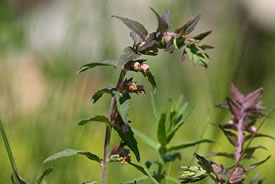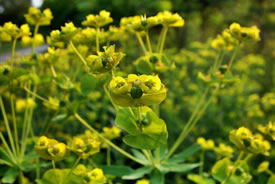Battling Buckthorn: NCC teams up with the Friends of the Pugwash Estuary for the fourth annual Buckthorn Beatdown

The Pugwash Estuary is a unique mixture of forest, marsh and sandy beaches (Photo by NCC)
On June 8, staff from the Nature Conservancy of Canada (NCC), Conservation Volunteers, the Friends of the Pugwash Estuary and the McMillan Forestry group braved hordes of mosquitoes to remove invasive glossy buckthorn at the Pugwash River Estuary...
Fighting the good fight: getting rid of garlic mustard

NCC staff tackle invasive garlic mustard (photo by NCC)
Spring on Pelee Island for Nature Conservancy of Canada (NCC) staff Mhairi McFarlane and Jill Crosthwaite is a bittersweet time, because although the wildflowers are emerging and birds are returning, so too is a nasty invasive plant: garlic...
Dealing with the periwinkle problem

Hand pulling periwinkle (Photo by NCC)
Jill and I did some follow up to some invasive species removal we did last year at Lathrop. Just a few fragments of the very invasive Periwinkle left! We picked them out by hand, leaving the native mayapple, trillium, Jack-in-the-pulpit and...
My first CV event: Nexen Energy interns help remove weeds in the badlands

Nexen CV event, Horseshoe Canyon, AB (Photo by NCC)
Less than a week into my internship with the Nature Conservancy of Canada (NCC), I attended my first Conservation Volunteers (CV) event on June 5, 2014. The NCC team arrived early at the site, located on the Nodwell-Horseshoe Canyon property, to...
Take a second look: Look-alikes in nature offer surprises in the field

Red bartisia (Photo by Kristian Peters, Wikimedia Commons)
It was late on a hot August day. I and my field partner were hiking across the tall grass prairie on one of our newly secured properties when we found a withered little reddish-purple plant. At first glance we thought, “Dang, that looks like...
What should we do about invasive species?

Leafy spurge (Photo by Ed L/pawpaw67)
Invasive alien species (IAS) have been identified by the International Union for Conservation of Nature as one of the greatest threats to biodiversity. It’s therefore no surprise that controlling and eradicating them is one of the top...
Getting rid of invasive species has never been more…delicious.

Maria Olkinitskaya picking dandelions at Baie Verte CV event, NB (Photo by NCC)
If you can’t beat them, eat them! Getting rid of invasive species has never been more…delicious. Invasive species management as a whole is extremely complex. However, cooking with certain edible invasives is a creative, fun and...
The end of the rainbow: Invasive species and the real costs of ecological monkey-wrenching

The once common and now rare rainbow clam (Villosa iris) (Photo by Karen Little, courtesy of Illinois State Museum)
Somewhere in the rivers of southern Ontario is a species few people have heard of, and even fewer have ever seen. It’s simply named the rainbow. The rainbow is a freshwater clam that gets its name from the rich iridescent colours on its...
Jetbead: A new threat to conservation

Mhairi McFarlane with leucospora (Photo by NCC)
Conservation is full of mysteries. Recently, my colleague Jill Crosthwaithe and I found ourselves having to turn to gardening literature in order to identify the many non-native, ornamental shrubs and other plants that we kept stumbling across in...
Grass carp: The new aquatic invader

Grass carp (Photo by Eric Engbretson, USFWS)
There has been a great deal of attention paid to the Asian carp invasion in recent years, and recently some devastating news was released: grass carp (Ctenopharyngodon idella) are probably already spawning in the Great Lakes basin(1). This...

